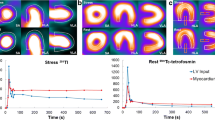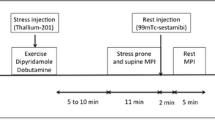Abstract
Rest technetium-99m sestamibi single-photon emission tomography (SPET) has been shown to under-estimate viability in some patients with chronic ischaemic myocardial dysfunction. The present study was designed to appraise the value of99mTc-sestamibi as a viability tracer in patients with a recent myocardial infarction and to determine factors that might influence its accuracy in assessing infarct size. Therefore, rest99mTc-sestamibi SPET, low-dose dobutamines stress echocardiography and quantitative coronary angiography were performed in 51 patients with a recent myocardial infarction. Perfusion activity and regional wall motion were scored semi-quantitatively using the same segmental division of the left ventricle. Assessment of99mTc-sestamibi uptake as a marker of viability was performed by comparing a binary uptake score (viable=>50% vs necrotic =≤50% of the maximal tracer activity) with a binary wall motion classification during low-dose dobutamine infusion (viable=normal/hypokinetic vs necrotic=akinetic/dyskinetic). Infarct size, expressed as the number of segments with evidence of necrotic tissue, was significantly greater in the scintigraphic study than in the echocardiographic study (2.8±1.5 vs 2.2±1.3,P=0.006). This overestimation of infarct size by99mTc-sestamibi was present only in patients with a severe infarct-related stenosis (% diameter stenosis ≽65%–100%) and particularly those with “late” reperfusion therapy (time delay ≽180 min). In patients without a severe infarct-related stenosis,99mTc-sestamibi was able to accurately distinguish viable from necrotic segments. Thus, rest99mTc-sestamibi scintigraphy early after acute myocardial infarction may underestimate residual viability within the infarct region, particularly in patients with low flow state coronary anatomy, as a result of a severe infarct-related stenosis and/or late reperfusion therapy.
Similar content being viewed by others
References
Ellis S, Henschke C, Sandor T, Wynne J, Braunwald E, Kloner R. Time course of functional and biochemical recovery of myocardium salvaged by reperfusion.J Am Coll Cardiol 1983; 1: 1047–1055.
Braunwald E, Kloner R. The stunned myocardium: prolonged, postischemic ventricular dysfunction.Circulation 1982; 66: 1146–1149.
Pierard L, De Landsheere C, Berthe C, Rigo P, Kulbertus H. Identification of viable myocardium by echocardiography during dobutamine infusion in patients with myocardial infarction after thrombolytic therapy: comparison with positron emission tomography.J Am Coll Cardiol 1990; 15: 1021–1031.
Smart S, Sawada S, Ryan T, et al. Low-dose dobutamine echocardiography detects reversible dysfunction after thrombolytic therapy of acute myocardial infarction.Circulation 1993; 88: 405–415.
Previtali M, Poli A, Lanzarini L, Fetiveau R, Mussini A, Ferrario M. Dobutamine stress echocardiography for assessment of myocardial viability and ischemia in acute myocardial infarction treated with thrombolysis.Am J Cardiol 1993; 72: 124G-130G.
Picano E, Lattanzi F, Orlandini A, Marini C, L'Abbate A. Stress echocardiography and the human factor: the importance of being expert.J Am Coll Cardiol 1991; 17: 666–669.
Beanlands R, Dawood F, Wen W, et al. Are the kinetics of technetium-99m methoxyisobutyl isonitrile affected by cell metabolism and viability?Circulation 1990; 82: 1802–1814.
Beller G, Glover D, Edwards N, Ruiz M, Simanis J, Watson D. Tc-99m sestamibi uptake and retention during myocardial ischemia and reperfusion.Circulation 1993; 87: 2033–2042.
Beller GA, Sinusas AJ. Experimental studies of the physiologic properties of technetium-99m isonitriles.Am J Cardiol 1990; 66: 5E-8E.
Sinusas AJ, Trautman KA, Bergin JD, et al. Quantification of area at risk during coronary occlusion and degree of myocardial salvage after reperfusion with technetium-99m methoxysiobutyl isonitrile.Circulation 1990; 82: 1424–1437.
Sawada S, Allman K, Muzik O, et al. Positron emission tomography detects evidence of viability in rest technetium-99m sestamibi defects.J Am Coll Cardiol 1994; 23: 92–98.
Rocco T, Dilsizian V, Strauss H, Boucher C. Technetium-99m isonitrile myocardial uptake at rest. Relation to clinical markers of potential viability.J Am Coll Cardiol 1989; 14: 1678–1684.
Marzullo P, Parodi O, Reisenhofer B, et al. Value of rest thallium-201/technetium-99m sestamibi scans and dobutamine echocardiography for detecting myocardial viability.Am J Cardiol 1993; 71: 166–172.
Marzullo P, Sambuceti G, Parodi O. The role of sestamibi sctinigraphy in the radioisotopic assessment of myocardial viability.Nucl Med 1992; 33: 1925–1930.
Baer F, Smolarz K, Theissen P, Voth E, Schicha H, Sechtem U. Regional Tc-99m methoxyisobutyl-isonitrile uptake at rest in patients with myocardial infarcts: comparison with morphological and functional parameters obtained from gradient-echo magnetic resonance imaging.Eur Heart J 1994; 15: 97–107.
Altehoefer C, Kaiser H, Dorr R, et al. Fluorine-18 deoxyglucose PET for assessment of viable myocardium in perfusion defects in Tc-99m MIBI SPET: a comparative study in patients with coronary artery disease.Eur J Nucl Med 1992; 19: 334–342.
Serruys W, Zijlstra F, Laarman G, Reiber H, Beatt K, Roelandt J. A comparison of two methods to measure coronary flow reserve in the setting of coronary angioplasty: intracoronary blood flow velocity measurements with a Doppler catheter, and digital subtraction cineangiography.Eur Heart J 1989; 10: 725–736.
Panza J, Dilsizian V, Laurienzo R, Curiel R, Katsiyiannis P. Relation between thallium uptake and contractile response to dobutamine: implications regarding myocardial viability in patients with chronic coronary artery disease and left ventricular dysfunction.Circulation 1995; 91: 990–998.
Gould K, Lipscomb K. Effects of coronary stenosis on coronary flow reserve and resistance.Am J Cardiol 1974; 34: 48–55.
Bisi G, Sciagra R, Santoro G, Fazzine P. Rest technetium-99m sestamibi tomography in combination with short-term administration of nitrates: feasibility and reliability for prediction of postrevascularization outcome of asynergic territories.J Am Coll Cardiol 1994; 24: 1282–1289.
Ito H, Tomooka T, Sakai N, et al. Lack of myocardial perfusion immediately after successful thrombolysis: a poor predictor of poor recovery of left ventricular function in anterior myocardial infarction.Circulation 1992; 85: 1699–1705.
Bolli R, Triana J, Jeroudi M. Prolonged impairment of coronary vasodilation after reversible ischemia. Evidence for microvascular “stunning”.Circ Res 1990; 67: 332–343.
Kloner R, Rude R, Carlson N, Maroko P, De Boer L, Braunwald E. Ultrastructural evidence of microvascular damage and myocardial cell injury after coronary artery occlusion: Which comes first?Circulation 1980; 62: 945–952.
Galli M, Marcassa C, Bolli R, et al. Spontaneous delayed recovery of perfusion and contraction after the first 5 weeks after anterior infarction: evidence for the presence of hibernating myocardium in the infarcted area.Circulation 1994; 90: 1386–1397.
Pellikka P, Behrenbeck T, Veram M, et al. Serial changes in myocardial perfusion using tomographic technetium-99m-hexakis-2-methoxy-2-methylpropyl-isonitrile imaging following reperfusion therapy of myocardial infarction.J Nucl Med 1990; 31: 1269–1275.
Sinusas A, Shi Q, Vitols P, et al. Impact of regional ventricular function, geometry, and dobutamine stress on quantitative Tc-99m sestamibi defect size.Circulation 1993; 88: 2224–2234.
Author information
Authors and Affiliations
Rights and permissions
About this article
Cite this article
Claeys, M.J., Rademakers, F.E., Vrints, C.J. et al. Comparative study of rest technetium-99m sestamibi SPET and low-dose dobutamine stress echocardiography for the early assessment of myocardial viability after acute myocardial infarction: importance of the severity of the infarct-related stenosis. Eur J Nucl Med 23, 748–755 (1996). https://doi.org/10.1007/BF00843702
Received:
Revised:
Issue Date:
DOI: https://doi.org/10.1007/BF00843702




